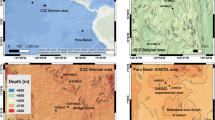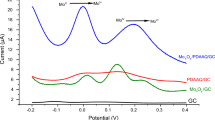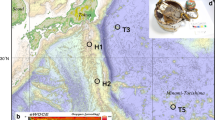Abstract
The dissolved state of chromium in seawater has long been studied and in particular which species, trivalent or hexavalent, is predominant. Research results are not, however, consistent, although the method used has usually been the same—using ferric hydroxide as coprecipitation carrier (Table 11–7). We have studied the coprecipitation behaviour of chromium with ferric hydroxide and other metal hydroxides in the presence of naturally existing inorganic and organic ions to attain an accurate analytical method for determining chromium content, as well as to estimate its behaviour in natural waters8,9. We report here that neither Cr(VI) nor organic species coprecipitate with ferric hydroxide in seawater; Cr(VI) can be quantitatively captured by the coprecipitation with bismuth hydroxide without any pretreatment (such as reduction); and the role of manganese oxide should be considered in addition to the amount of dissolved oxygen to understand the redox system of chromium in natural waters. The inconsistency of the past research may therefore be partly because the presence of organic species was not taken into account and was analysed as either Cr(VI) or Cr(III) or overlooked entirely.
This is a preview of subscription content, access via your institution
Access options
Subscribe to this journal
Receive 51 print issues and online access
$199.00 per year
only $3.90 per issue
Buy this article
- Purchase on Springer Link
- Instant access to full article PDF
Prices may be subject to local taxes which are calculated during checkout
Similar content being viewed by others
References
Chuecas, L. & Riley, J. P. Analyt. chim. Acta 35, 240–246 (1966).
Fukai, R. Nature 213, 901 (1967).
Fukai, R. & Vas, D. J. oceanogr. Soc. Jap. 23, 298–302 (1967).
Kuwamoto, T. & Murai, S. Preliminary Rep, Hakuho-maru Cruise KH-68-4, 72 (Ocean Research Institute, University of Tokyo, 1970).
Grimaud, D. & Michard, G. Mar. Chem. 2, 229–237 (1974).
Yamamoto, T., Kadowaki, S. & Carpenter, J. H. Geochem. J. 8, 123–133 (1974).
Cranston, R. E. & Murray, J. M. Analyt. Chim. Acta 99, 275–282 (1978).
Fujinaga, T., Kuwamoto, T., Murai, S., Kihara, S. & Nakayama, E. Nippon Kagaku Zasshi 92, 339–344 (1971).
Fujinaga, T., Kuwamoto, T., Nakayama, E. & Tsurubo, S. Abstr. Papers ACS/CSJ Chem. Congr. Envir. Chem. No. 100 (Honolulu, Hawaii, 1979).
Elderfield, H. Earth planet. Sci. Lett. 9, 10–16 (1970).
Turekian, K. K. Chemical Oceanography Vol. 2, 81–125 (Academic, New York, 1955).
Masuzawa, T. Abstr. oceanogr. Soc. Jap., 148–149 (1978).
Author information
Authors and Affiliations
Rights and permissions
About this article
Cite this article
Nakayama, E., Tokoro, H., Kuwamoto, T. et al. Dissolved state of chromium in seawater. Nature 290, 768–770 (1981). https://doi.org/10.1038/290768a0
Received:
Accepted:
Issue Date:
DOI: https://doi.org/10.1038/290768a0
This article is cited by
-
Interplay of transport processes and interfacial chemistry affecting chromium reduction and reoxidation with iron and manganese
Frontiers of Environmental Science & Engineering (2020)
-
The behavior of trace elements in seawater, sedimentary pore water, and their incorporation into carbonate minerals: a review
Facies (2019)
-
Redox-independent chromium isotope fractionation induced by ligand-promoted dissolution
Nature Communications (2017)
-
Sorption behavior of nine chromium (III) organic complexes in soil
International Journal of Environmental Science & Technology (2010)
-
Preconcentration of Cr(VI) ion on melamine formaldehyde resin
Fresenius' Journal of Analytical Chemistry (1992)
Comments
By submitting a comment you agree to abide by our Terms and Community Guidelines. If you find something abusive or that does not comply with our terms or guidelines please flag it as inappropriate.



